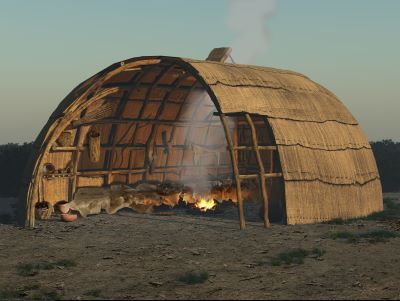Last updated: July 12, 2023
Lesson Plan
Introduction to the Kecoughtan People: "Home" in an Indigenous Tidewater Virginia Town

- Grade Level:
- Upper Elementary: Third Grade through Fifth Grade
- Subject:
- Literacy and Language Arts,Social Studies
- Lesson Duration:
- 60 Minutes
- State Standards:
- Virginia Standards of Learning:
VS.1 a) and b)
VS.2 a) and e) - Additional Standards:
- Common Core Standards:
SSS2.4.1
SSS2.4.2
SSS3.4.1
SSS4.4.3 - Thinking Skills:
- Understanding: Understand the main idea of material heard, viewed, or read. Interpret or summarize the ideas in own words. Analyzing: Break down a concept or idea into parts and show the relationships among the parts.
Essential Question
Who were the Kecoughtan people and what was their life in Tidewater Virginia like?
What makes a home and how are ideas of home similar and different in different cultures?
Objective
At the end of the lesson, students will be able to discuss the Kecoughtan, an Indigenous group who were located in what is now Hampton, Virginia at the time of English arrival. They will be able to describe Kecoughtan homes, families, food, games, and clothing. Additionally, they will be able to define the word "perspective" and understand how perspective can help us understand past cultures.
Preparation
Materials needed:
Note Sheet 1
Note Sheet 2
Work Sheet Notes
Extension Activity Sheet
Writing & drawing materials
Materials
Note Sheet 1
Note Sheet 2
Worksheet Notes
Extension Activity
Comparison Activity
Procedure
Engage
Introduction Activity:
Open the lesson by asking students to brainstorm all the things that make a home feel like home. By encouraging many different suggestions, the instructor should welcome various interpretations. Ultimately, students should be guided into narrowing down a list of five necessities for the home: food, clothing (what do you wear inside of a home), shelter, fun, family.
Next, guide students into a discussion about different types of homes people live in all over the world.
Example dialogue: Did you notice how we had many different ideas about what makes a home? Each of us thought a little bit differently. This is called perspective. Perspective is the many ways in which something can be seen. Today, I am going to give you some information about two groups of people with different ideas about what makes a home. They are English explorers who landed at Pointe Comfort, near Hampton, Virginia in 1607, and the first tribe of Native Americans they met, the Kecoughtan people. The Kecoughtan were part of a population of Native Americans who had lived on the land for centuries. You will now be split into groups of five. Let's think back to our original discussion about what makes a home: food, family, fun, shelter, and clothing. Pretend that you are the English explorers seeing the Kecoughtan village for the first time. Your job is to read about one element of home for the Kecoughtan people, and report back to the class about your findings. Each group must answer their worksheet’s related questions. We will then share these answers as a class.
Students will then be broken up into five groups and given Notes Worksheet 1 and 2, and the corresponding Student Answers Notes Worksheet to record answers to their questions. Worksheet 1 and 2 contain five informational sections that discuss domestic elements of Kecoughtan daily life in the early 17th century. Once the instructor has given enough time for students to read and record answers, each group should report out on their findings.
Explore
Next, students will be given a worksheet with pictures of 16th century English cottages and a Native American yihakans. With table partners, students will be asked to compare and contrast the different elements of the inside and outside of each dwelling. Students will use the corresponding Venn Diagram to look for similarities and differences by labeling them on the chart.
Suggested Dialogue: Now that we have had a chance to meet the Kecoughtan people, let's compare and contrast their elements of home with the English explorers. You will see that each culture has many of the same things, they are just made differently. With a partner, please list these similarities and differences in the Venn Diagram.
Suggested comparative element that may be used for guidance.
-
Storage containers
-
Fire pits
-
Beds
-
Walls
-
Flooring
-
Lighting
-
Sitting spaces
Extension Activity
Finally, students will be asked to design a dwelling based off natural elements one could find in the Chesapeake Bay, today. Students will transfer their ideas by drawing and labeling the materials on the sketch of a house.
Additional Resources
Fort Monroe National Monument
Captain John Smith Chesapeake National Historic Trail
Virginia's State-Recognized Tribes
Virginia Department of Education - Virginia's First People
William & Mary Research at Historic Kecoughtan
Related Lessons or Education Materials
We Have a Story to Tell: Native Peoples of the Chesapeake Region (Smithsonian)
This lesson plan was written by Ashley Ranalli, who served as the trail's seasonal park guide in 2022. Ranalli is a schoolteacher in Virginia who also has several years of experience working with the National Park Service as a park guide. While developing the lesson, Ranalli consulted with teachers from the local area and Tribal members, including Autumn Fortune-Dueber of the Chickahominy Tribe.
